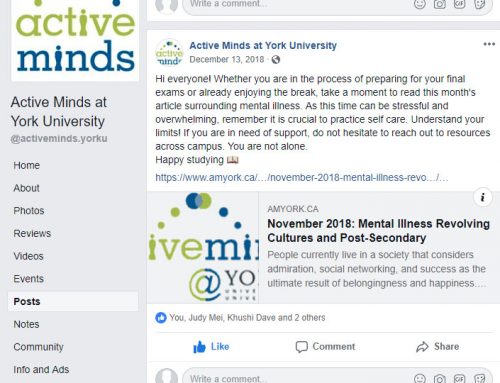The culture that universities and colleges uphold can dictate not only how students feel about their mental health but also whether they decide to seek help
Being a university or college student can be demanding; keeping up with the rigorous academic pressures alone is stressful. However, students may also face other challenges such as: worrying about school – related finances, trying to stay involved in extracurriculars, making time for a social life, and making time for themselves. If students are not aware of how to manage their stress or take time for themselves, this could lead to negative effects on their mental well-being. Mental health plays a vital role in how students function in their daily activities; whether that be excelling in their academics, maintaining a routine or keeping up with social connections (Engelhardt, 2016). A Canadian campus survey found that 42% of university students were more likely than non-university students (17%) to report symptoms of mental illness (Giamos, 2017). It is important that schools not only acknowledge that students may be at more risk to mental health problems but that there needs to be more focus on providing education, resources, accessibility to resources and creating a culture that promotes help seeking behavior from its students.
On September 28th, 2019, a student took their life at the University of Toronto, St. George campus inside the Bahen Centre for Information Technology building. Students are now criticizing the institution for not addressing the death as a suicide in order to protect their reputation. A few students also spoke out about the culture that UofT has upheld, as being one where “you are not supposed to eat, you are not supposed to sleep, you are not supposed to take care of yourself, and that’s what we equate with success” (Nasser, 2019). Students are now advocating for better mental health services to eliminate the culture that the school has created. They specifically voiced the need for shorter wait times when seeking counseling, more accessibility to mental health campus resources, and that the school acknowledge when a suicide occurs on campus (Nasser, 2019). In response, the universities’ solution was to place barriers at the site of where the suicide occurred. While this solution may stop future incidents from happening at that building, it still doesn’t effectively address the greater issue of the lack of resources accessible to students.
It is equally important for schools to understand how students can suffer from a culture that ratifies a stigma. Institutions that create a culture of misinformation or lack of information regarding mental health can foster a negative stigma, and thus can prevent students from seeking help. It is essential for schools to not only be open to discussions around mental well-being but also to providing education about coping strategies and professional resources for students to reach out to. Furthermore, the promotion of mental health services and the quality of the services are also important in making students feel understood about their issues and continue reaching out. Universities and colleges not only have the access to reach a target population that significantly faces mental health problems, but they also have the advantage of providing central accessible locations which would make it easier for students to reach out for help. Being an educational institution and keeping a focus on mental health services can lead to the development of improved interventions, prevention measures and better diagnosis (Engelhardt, 2016). Additionally, previous research on supporting student mental health has suggested that schools could provide accommodations for students experiencing ongoing mental illnesses and referrals for students with more severe mental problems (Engelhardt, 2016).
By creating a responsive and supportive culture, this will promote more open discussions about mental health and help students feel more comfortable in reaching out for help. Providing these tools can not only aid students during their academic careers, but it can also provide them with skills they can take with them throughout the rest of their lives.
References
Engelhardt, M. (2016). Examining Mental Health in Schools and the Role it Plays in Supporting Students. Saskatchewan Educational Leadership Unit, 1(2), 17-28. Retrieved from https://selu.usask.ca/research-publications-and-awards/srrj.php#CurrentIssue
Giamos, D., Lee, A. Y. S., Suleiman, A., Stuart, H., & Chen, S.-P. (2017). Understanding Campus Culture and Student Coping Strategies for Mental Health Issues in Five Canadian Colleges and Universities. Articles Canadian Journal of Higher Education, 47(3), 136–151. doi: 10.7202/1043242ar
Nasser, S. (2019, September 30). University of Toronto to erect temporary barriers at Bahen Centre as concerns mount over student suicides. CBC. Retrieved from https://www.cbc.ca/news/canada/toronto/university-toronto-bahen-death-suicides-1.5302238
Nasser, S. (2019, September 30). U of T students demand change in wake of suicide on campus. CBC. Retrieved from https://www.cbc.ca/news/canada/toronto/students-university-of-toronto-uofthrive-uoftears-student-suicide-1.5303564



























